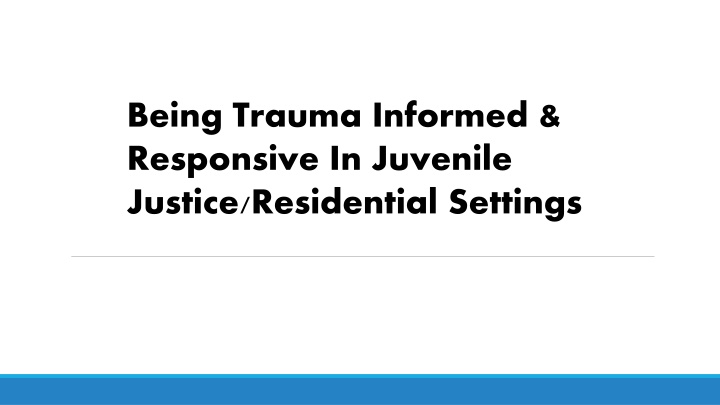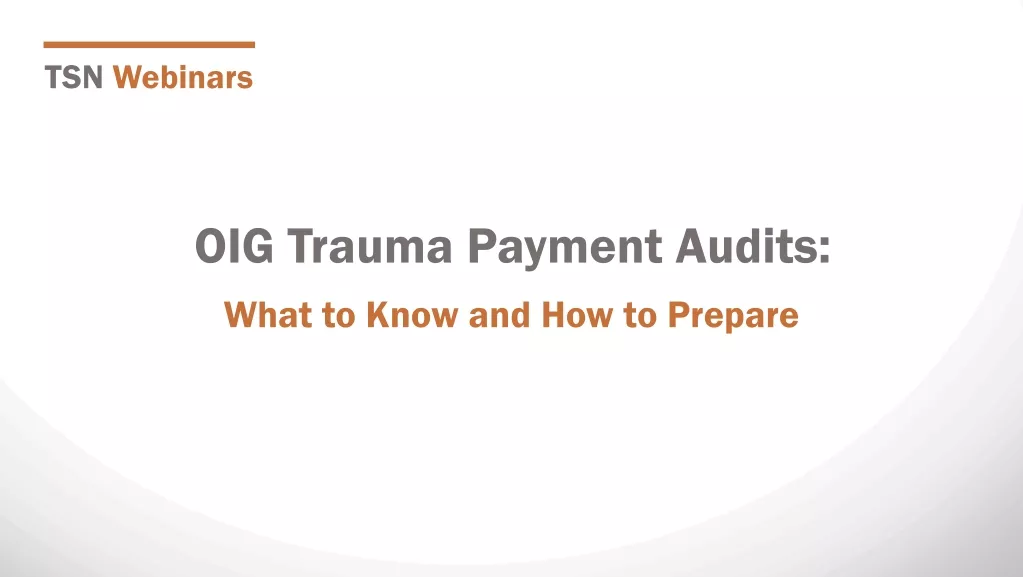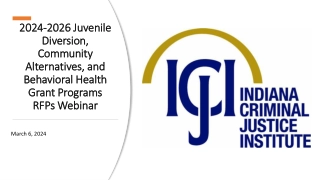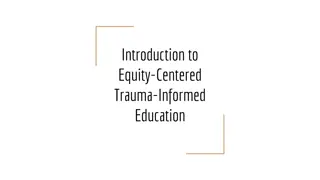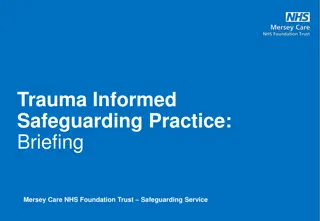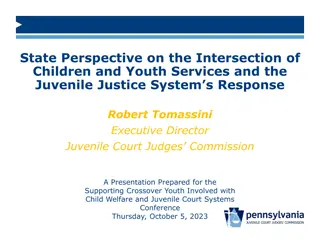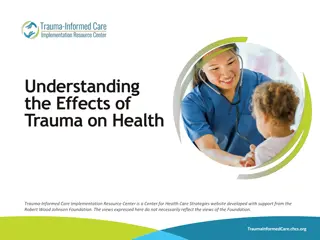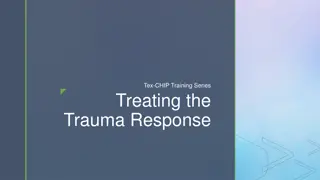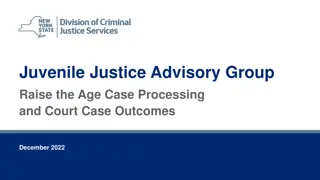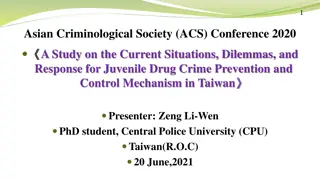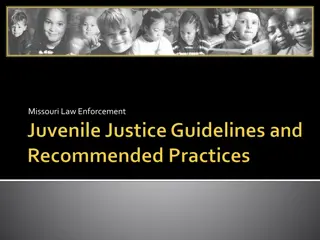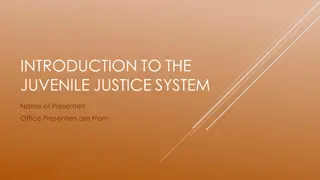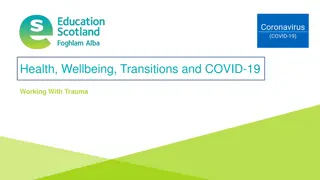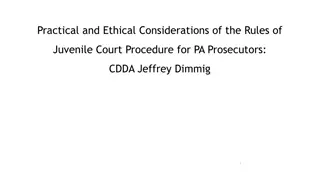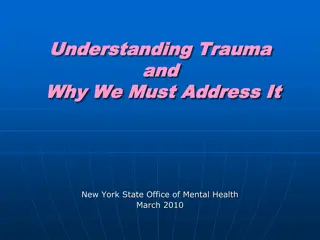Being Trauma Informed & Responsive In Juvenile Justice/Residential Settings
Impact of trauma on youth in residential settings, emphasizing safety, respect, and self-care strategies. Learn about traumatic stress, brain development, and long-term effects on physical and mental health. Understand Adverse Childhood Experiences (ACE) and how to provide trauma-informed care.
Download Presentation

Please find below an Image/Link to download the presentation.
The content on the website is provided AS IS for your information and personal use only. It may not be sold, licensed, or shared on other websites without obtaining consent from the author.If you encounter any issues during the download, it is possible that the publisher has removed the file from their server.
You are allowed to download the files provided on this website for personal or commercial use, subject to the condition that they are used lawfully. All files are the property of their respective owners.
The content on the website is provided AS IS for your information and personal use only. It may not be sold, licensed, or shared on other websites without obtaining consent from the author.
E N D
Presentation Transcript
Being Trauma Informed & Responsive In Juvenile Justice/Residential Settings
The Training Environment Safety is priority Voluntary participation Demonstrate respect Preserve confidentiality Limit over-sharing of student or personal concerns Encourage self-protection Attend to self and others
PART I: PART I: Trauma & Sensory Processing 101
Part I Objectives By the end of this section, attendees will be able to: Define traumatic stress, its characteristics and prevalence Discuss the potential impacts of trauma on the developing brain & sensory processing Discuss long term physical and mental health impacts of trauma Discuss compassion fatigue and self-care strategies
Defining Trauma (3Es) Trauma (3Es) 3Es) 3Es)Defining Trauma is an event, series of events, or set of circumstances that is experienced by an individual as physically or emotionally harmful or threatening and has lasting adverse effects on the individual's functioning and physical, social, emotional, or spiritual well-being. www.SAMHSA.gov
Trauma. is pervasive can impact childhood development and behavior has a far reaching and long lasting impact affects how youth and families approach services designed to help them
Traumatic Stress. Leads to changes in brain development Produces symptoms of dysregulation, hyper-sensitivity, and avoidance Impacts memory and visual processing May lead to inattention, aggression, academic and social challenges Nat l Center for Mental Health Promotion and Youth Violence Prevention, 2012
Long Term Impacts: Long Term Impacts: The Adverse Childhood Experiences (ACE) Study 1997 study conducted by CDC & Kaiser Permanente Surveyed 17,000 adults (middle aged, white, middle income) Counted adverse childhood experiences (up to 10) 2/3 had at least one ACE; 12% had 4 or more Principal Investigators: R. Anda, MD, MS and V. Felitti, MD
Traumas Prevalence in Michigan Trauma s Prevalence in Michigan 17% Michigan adults reported experiencing physical abuse before the age of 18 1 11% Michigan adults reported sexual abuse 1 28.5% Michigan children 0-17 reported 2 or more adverse childhood experiences 2 Michigan children whose household income is 0-99% of FPL reported 2 or more adverse childhood experiences 2 42.2% Those who receive Children s Special Health Care Services reported 2 or more adverse experiences 2 48.7% 1 - 2013 MIBRFSS 2 - 2011-12 National Survey of Children s Health
Findings: As ACE Score , So Does Risk For: (ACE Score 4 or More) Suicide attempts (12.2) Pulmonary disease (3.9) Heart disease (2.2) Liver disease (2.4) Lost time from work (2.5) Early death (Those with ACE score of 6 or more, died 20 years earlier) Smoking (2.2) Multiple sexual partners (3.2) Adult alcoholism (7.4) Drug use (4.7) STDs (2.5) Depression (4.6)
Children who experience trauma are: 2.5x more likely to fail a grade in school Score lower on standardized achievement tests More likely to have struggles in receptive & expressive language Suspended & expelled more often More frequently placed in special education
3 Primary Categories of Response Fight Flight Freeze (Physical Arousal) (Withdrawal & Escape) (Stilling & Constricting) Constricted emotional expression Aggression Social isolation Trouble concentrating Avoidance of others Stilling behavior Over compliance and denial of needs Hyperactivity Running away
Trauma Triggers (Reminders) Are rarely clear Often unnoticed, even by the individual Can be invisible (sensory oriented) Can seem trivial/minor Are often uncontrolled factors Don t always make sense Revert us to less functional versions of ourselves
Behaviors we see Fear of being separated from parent Extreme withdrawal Flashbacks Nightmares/sleep problems Crying, whimpering, screaming Disruptive behavior Emotional numbing Immobility and/or aimless motion Inability to pay attention Ages 0-5 Avoidance of reminders Trembling, excessive clinging, frightened facial expressions Regressed behaviors Depression Regressed behaviors Nightmares/sleep problems (thumb-sucking, bed-wetting, fear of darkness, etc.) Substance abuse Irrational fears Self-soothing Ages 12-17 Ages 6-11 Problems with peers (rocking, head-banging, etc.) Irritability Anti-social behavior School refusal Physical complaints Anger outbursts Suicidal ideation Fighting School problems Somatic complaints Confusion Poor academic engagement (school work suffers) Guilt Revenge fantasies Depression, anxiety, feelings of guilt, emotional numbing
Explaining The Brain to Children & Adolescents https://vimeo.com/109042767 4:40 Minutes
Trauma is SENSORY EXPERIENCE because of what happens to the brain and memory during trauma.
Sensory Processing and Trauma Children with a history of trauma demonstrate a significant prevalence of sensory processing disorders (Atchison, 2008)
Sensory Over-Responsivity Children who are over-responsive tend to respond too much, too soon or for too long to sensory stimuli that other children tolerate easily General Behavior: May be challenged with transitions, appear controlling and/or defiant
Sensory Under-Responsivity Children who are under-responsive tend to respond less, or more slowly to sensory stimuli that other children respond to General Behavior: May be challenged with transitions, appear lethargic or inattentive
Sensory Seeking or Craving Children who are seeking stimuli may be more active and physical than other children General Behavior: May be challenged with settings that require quiet and still movement
Good News: The Amazing Brain Neuroplasticity- Changes in response to trauma, and in response to supportive adults Neurogenesis- the ability to grow new neurons, to increase connectivity Neural Networks- The more intensely and frequently a neural network fires, the stronger its wiring. In short, repetition is a good thing.
Pause PAUSE 1. What is your reaction to the information so far? Did anything surprise you? 2. Does it change the way you see the youth you work with? How so? 3. Can you think of youth/adults you work with who have any of these behaviors? 4. How does/might traumatic stress affect the youth/families you work with?
Compassion Fatigue Increased exposure to trauma affected [youth] Unsupportive work environment Organizational constraints Insufficient supervision Ability to engage empathically with others Symptoms of anxiety, intrusive thoughts, anhedonia, isolation, and career dissatisfaction
Symptoms of Compassion Fatigue/Vicarious Trauma
The ABC Approach Connection Awareness Balance
Personal & Professional Boundaries Reflect: What sort of personal/professional boundaries do you create for yourself? Who is there to help you manage the stress of your job? Where do you feel supported at work? peer-supervision/ supervision/consultation? What steps are possible for you to take in your building to support staff?
PART PART II: II: Trauma & Sensory Related Strategies
Part II Objectives Discuss keys for integrating trauma informed principles Describe strategies for responding to trauma-related behaviors Identify environmental strategies that support healing & resilience
Trauma Informed Services Compassionate care An approach not an intervention Supports healing & resilience
Why Is This Important? https://vimeo.com/103538479
Why Trauma Informed Services? Recovery and healing are possible Protective factors facilitate healing and resilience Healing occurs within the context of RELATIONSHIPS. adapted from Fallot and Harris, 2002
Trauma-Informed Professionals Appreciate the high prevalence of traumatic experiences among youth Understand the profound neurological, biological and social effects of trauma and violence Engage with youth in a manner that recognizes and addresses trauma- related issues Are collaborative, supportive, and skilled adapted from Harris and Fallot, 2001 and NASMHPD, 2003-present
Trauma Informed Services: Key Principles Safety Collaboration Voice & Choice Cultural, Historical & Gender Issues Trustworthiness Peer Support SAMHSA: The Concept of Trauma and Guidance for a Trauma Informed Approach
Elements of Trauma Informed Environments SAFETY precedes learning FEAR overrides ability to think clearly BEHAVIORS communicate feelings ENVIRONMENT & ACTIVITIES can calm RELATIONSHIPS can heal NON-VERBALS are powerful TEAMWORK and shared responsibility are vital CONNECTIONS across system Adapted from NCTSN: Child Trauma Toolkit for Educators (2008)
Policies, Procedures, and ProtocolsoliciProcedures and Protocols Clearly articulated boundaries and expectations are a key part of trauma-informed practice and equally important in the larger system. Adoption of social-emotional learning standards, restorative practices, and positive behavioral response protocols is a powerful lever for supporting all youth to succeed, and takes dedicated resources, including training, ongoing coaching, infrastructure building, and partnership from the behavioral health field. Tracey Schear, Alameda County , CA
A JOURNEY. Trauma Aware Trauma Sensitive Recognition of trauma prevalence and impact on child development and learning/behavior Trauma Responsive Beginning exploration of TIS principles within environment Beginning of change in culture to highlight role of trauma Consensus building around principles of TIS TIS principles integrated at all levels PREPARE for change Ultimate Outcome: Trauma Informed Missouri Model: A Developmental Framework for Trauma Informed, MO Dept. of Mental Health and Partners (2014).
Overall. Not But What is wrong with you? What happened to you?
Handling Disclosures of Trauma Be prepared After disclosure Expect disclosures Acknowledge & validate Know agency policies & protocols Remind about confidentiality & reporting requirements Know state reporting laws Follow up & stay connected Discuss confidentiality & reporting requirements Have referral info available JSI Research and Training Institute, http://rhey.jsi.com
Pause 1. What is your reaction to the information about trauma-informed services? Did anything surprise you? 2. Does it change the way you may work with youth in your organization? How so? 3. How might you apply trauma informed principles to the youth/adults you thought about earlier? Use the following worksheet to compare your current practices with practices that might be more trauma-informed.
Strategies Reason Relate Regulate Perry, B.D. (2006)
Start at the Bottom: Regulate Manage your own reactions Recognize that the youth s behavior is communicating feelings or loss of control Validate youth s emotion then guide toward calm Limit questions Call on practiced proactive strategies/ exercises
Regulate: Regulate: Consider the Environment Create quiet/safe spaces Be aware of lighting and background noises Encourage respect for personal space Develop predictable routines Provide advance notice for transitions and changes of routines Create opportunities for sensory organizing movement throughout the day
Regulate: Regulate: Proactive Strategies Reorient to the present Focus on immediate environment Imagery Breathing/ mindfulness meditation/ yoga Exercise/ experience with nature Teach about the brain & senses & how they react
Heres Some Recommendations Oral-Sensory Strategies: Chewing gum, biting your nails, eating snacks Movement Strategies: Rocking in your chair, going for a run, bending over, dancing Touch Strategies: Twirling your hair, squeezing a stress ball, holding something soft in your hand Auditory Strategies: Do you listen to a particular type of music or hum to yourself? Visual Strategies: Watching a fire or fish tank, reading a book, watching a lava lamp.
We All Have Strategies What strategies do you recommend?
Just Breath video link https://youtu.be/RVA2N6tX2cg
Next Step Up: Relate The connection between youth who have experienced trauma and adults is essential to the healing process The brains of children who have experienced trauma may have learned to associate adults with negative emotions Youth benefit from positive interactions with adults
https://www.youtube.com/watch?v=VxyxywShewI 3:50 Minutes
Relate First regulate with the youth, then Relate: Tone of voice and volume? Youth s relational needs? What communication modes will support them in this moment? Body language to support a relationship? Positive communication Listen without trying to solve Avoid trying to make it better
Relate: Relate: Build Empathy with Youth REFRAME: What happened to you? not, What s wrong with you? REFRAME: Symptoms are adaptive coping necessary to survive, not as pathology REFRAME: Behaviors as communication that can lead to understanding PTSD symptoms are typical reactions to atypical circumstances. The individual is a survivor. Celebrate their survival mechanism(s)
